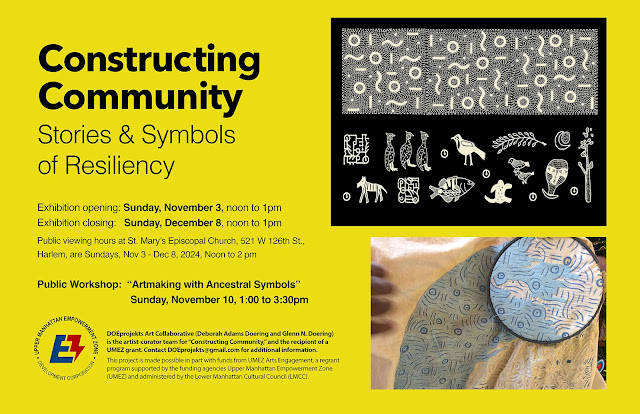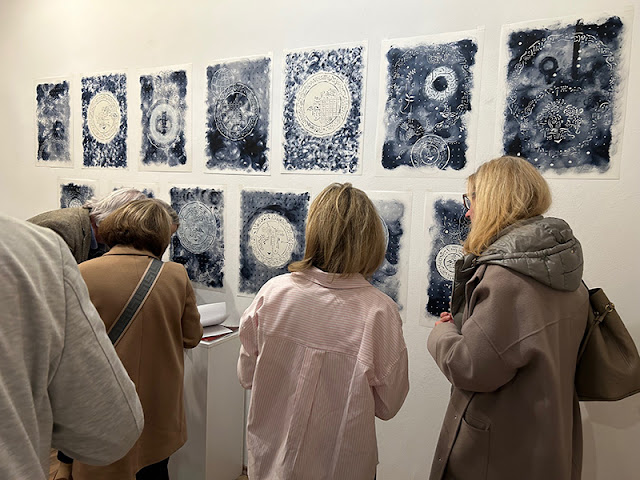Above: A selection of the two-dozen cyanotype prints created by Deborah Adams Doering and Glenn N. Doering. DOEprojekts participated in three “Earth Matter: Cyanotypes” workshops on Governors Island in 2024.Imagine prussian-blue cyanotype prints in multiple stages of development are scattered in all directions. We are two of the fifteen printmakers intent upon their craft on a sunny, breezy day on Governors Island, NY; some of us are inside the studio-exhibition space, experimenting with compositions featuring decaying items from nearby compost mounds, and others are outside, combing through garden clippings, searching for appropriate elements that will complete their compositions in the most aesthetic way.
One goal of the imminent “show” is creating memorable images that will serve as visual reminders that the earth needs help in supporting healthy human and animal life, and that composting is one way to assist. More important than the resulting prints however, is the nascent act of forming a community interested in sharing sustainable practices.
Above: Printmakers display their cyanotype works at the Earth Matter studio workshop.DOEprojekts participated in “Earth Matter: Cyanotypes” three times during the summer of 2024. The creative workshops and resulting displays arise from the initiative of two individuals: Bryen Pittner and Brian Buckley.
Above: Bryen Pittner and Brian Buckley, in the garden and in the studio.Bryen Pittner works as “Farm Artist and Facilitator” at the nonprofit Earth Matter NY; EMNY’s mission is to reduce the organic waste misdirected into garbage streams through neighborhood participation in composting, educational workshops, and printmaking shows. In 2023, Bryen contacted “the other Brian” and proposed writing a grant for a series of workshops at the EMNY composting facility. The Lower Manhattan Cultural Council (LMCC), an organization that has supported DOEprojekts with several grants in the past 10 years, approved EMNY’s proposal and funded the 2024 workshop-exhibitions.
Above: Brian Buckley’s personal art practice includes a variety of cyanotype techniques.Key to the LMCC grant award is Buckley’s expertise in experimental photography. As part of his art practice, he reinterprets photography’s earliest techniques, particularly cyanotypes and other camera-less methods, which allow for group collaboration and communal gatherings. EMNY’s composting mounds, gardens, and studio-exhibition space prove ideal for Buckley’s sunlight-driven process and product.
The photo-printmaking process, we learned, has several steps that require patience and precision. Cyanotypes require a smooth, stiff, hot-pressed paper, since photo-sensitive chemicals need to adhere to, but not be fully absorbed by, the paper-substrate. We mixed the chemical compound (Ferric ammonium citrate and Potassium ferricyanide) shortly before application to the paper. The chemicals have a low toxicity and support EMNY’s earth-friendly mission. Mixing, applying the chemicals, drying the prepared surface, arranging the compost material, and exposing the composition to the sun, is considered part of the ecological “show.”
Above left: Compostable objects are aesthetically arranged on cotton paper that has been treated with low-toxic, light-sensitive chemicals. Above right: The resulting cyanotype print.After exposure to the sun, the objects were returned to compost piles and the paper was rinsed in water; the ghostly outlines of various compostables – both human and nature-made – mystically appeared. Our group of printmakers never tired of watching the wizardry; oohing-ahhing at a developing print was an adjacent soundtrack to crickets chirping and bees buzzing.
One print in particular is magical; the wind caused some of the compostables to shift slightly during the developing process. Spectral vibrations are part of each object’s outline such that the forms suggest a dialogue between humans and nature. The fully developed print displays a commercial wrapper and a circle-graphic integrated with willowy weeds, a large tree leaf, and a flower. The print advances an abstract of the show’s ecological significance. As artists, we want to be supportive of the earth, but often the processes used to create our works can sometimes be toxic. Through community printmaking education using low-toxic printmaking techniques like cyanotypes, artists create aesthetic images, but more importantly, they support each other in the ongoing practices that sustain the earth.
Above left: Printmaking community displayed their cyanotypes at the third Earth Matter Cyanotype workshop. Glenn and Deborah, far right, display their T-shirt cyanotypes.






































